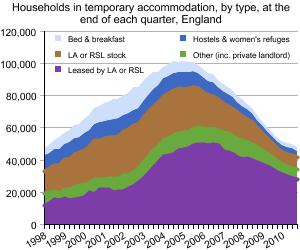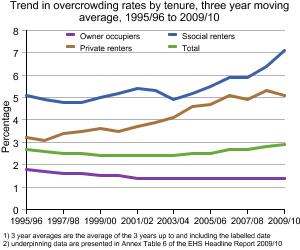Information is provided on two forms of homelessness, statutory homelessness and rough sleeping, as well as wider information on housing need, such as overcrowded households.
Publications
The Indices of Multiple Deprivation for England combine a number of areas, chosen to cover a range of economic, social and housing issues into a single deprivation score for each Lower Layer Super Output Area in England. The Atlas of Deprivation allows a map visualisation of the overall LSOA deprivation score (rank) and the score (rank) for each of the seven domains by local authority.
Public attitudes towards housing issues.
Data submitted by Administering Authorities for the four quarters has been validated and used to derive nationals baseline figures for DSO indicators 2.10 and 2.11 (Supporting People).
Homelessness Prevention and Relief data

Presents data on the number of homeless in Wales.

Provides an estimate of the number of households in England.

Routine update of housing statistics web tables plus summary of key trends

Presents the results from the Survey of English Housing.

Presents key facts about Welsh Housing.

Compendium of housing and planning statistics covering most aspects of housing and planning in England
Statistics submitted to CLG by local authorities on the Mortgage Rescue Scheme

Statistics on housing compiled by Department for Social Development Housing Division and Northern Ireland Housing Executive.
Information on new house sales and prices, actions for mortgage possessions, and new housing starts.

Applications, numbers in temporary accommodation, and snapshot of characteristics of applicants and local authority responses.
Rough sleeping, total count
Rough sleeping counts and estimates in England, by local housing authority

Presents information about possession orders and eviction warrants obtained against tenants of social landlords (local authorities and registered social landlords) in Wales.
Social lettings information recorded on CORE (Continuous Recording of Lettings) adjusted for missing local authority landlord data.

Data on households found to be homeless.
Supporting People Quarterly Client Records and Outcomes
Overview
Statutory homelessness
English local housing authorities report information on their activities under homelessness legislation. Data include the number of households accepted as owed a main homelessness duty during each quarter, and the number of households in temporary accommodation on the last day of each quarter.
Rough sleeping
The most visible and extreme form of homelessness is that of people sleeping on the streets. Following a public consultation in summer 2010 the Department published revised guidance on evaluating the extent of rough sleeping. The new guidance has been used by local authorities for carrying out counts and providing robust estimates from October 2010.
The autumn 2010 total of rough sleeping counts and estimates in England was 1,768.
Overcrowding
The generally accepted benchmark for determining whether a household is overcrowded is the bedroom standard. The latest estimate, averaged over the three years 2007-08 to 2009-10 is that there are about 630,000 overcrowded households in England.
Technical Data
Statutory homelessness
Local housing authorities report their activities under Part 7 of the Housing Act 1996 to Communities and Local Government by completing the quarterly P1E statistical return. The Act places statutory duties on local housing authorities to provide assistance to people who are homeless or threatened with homelessness.
Authorities must consider all applications from people seeking accommodation or assistance in obtaining accommodation. A main homelessness duty is owed where the authority is satisfied that the applicant is eligible for assistance, unintentionally homeless and falls within a priority need group.
Where a main duty is owed, the authority must ensure that suitable accommodation is available for the applicant and his or her household until a settled home becomes available for them. Statutory homelessness statistics are published on a pre-announced date in accordance with the National Statistics Code of Practice, in March, June, September and December of each year.
Rough sleeping
Rough sleeping counts and estimates are single night snapshots of the number of people sleeping rough in local authority areas. Local authorities decide whether to carry out a count or an estimate based upon their assessment of whether the local rough sleeping problem justifies counting.
Overcrowding
The Bedroom Standard (see glossary for more information) is used to ascertain whether a household is overcrowded. The overcrowding estimates are derived from the English Housing Survey (EHS) and the predecessor Survey of English Housing (SEH), which ran as a continuous annual survey from 1993/94 to 2007/08.
The surveys were managed and funded by Communities and Local Government and the fieldwork and analysis was contracted out. Fieldwork involved interviewing around 18,000 households a year, drawn randomly from across the whole country.
In April 2008 a the EHS was formed by merging the SEH with another former Communities and Local Government survey, the English House Condition Survey (EHCS).
Glossary
-
Acceptances
Households found to be eligible for assistance, unintentionally homeless and falling within a priority need group (as defined by homelessness legislation), during the quarter, are referred to as ‘acceptances’. These households are consequently owed a main homelessness duty by a local housing authority. The main duty is to secure settled accommodation.
-
Bedroom Standard
The bedroom standard for a household is derived by taking into account the number of people in the household, their relationships to one another, their age and gender and by then applying a set of rules to determine how many household members require a bedroom of their own and how many can be expected to share. The total number of bedrooms determined by this approach is the bedroom standard. If the number of bedrooms available to them is below this standard then they are overcrowded. If they have at least two bedrooms more than the bedroom standard then they are said to be under-occupied.
-
Decisions
All households that apply for assistance under the Housing and Homelessness Acts. However, these do not include households found to be ineligible for assistance (some persons from abroad are ineligible for assistance).
-
Households for whom a duty is owed, but no accommodation has been secured (previously called "Homeless at home")
These are households who have been accepted as being owed a main homelessness duty and for whom arrangements have been made for them, with consent, to remain in their existing accommodation (or to make their own arrangements) for the immediate future. This was previously referred to as “Homeless at Home”.
-
Overcrowded
A household that has fewer bedrooms than implied by the bedroom standard is deemed to be overcrowded. Since one bedroom will be sufficient for single person households and for married/cohabiting couples, these households cannot be overcrowded according to the bedroom standard.
-
Priority need groups
Include households with dependent children or a pregnant woman and people who are vulnerable in some way. The priority need categories were extended by Order in January 2002 to include, additionally: applicants aged 16 or 17; applicants aged 18 to 20 who were previously in care; applicants vulnerable as a result of time spent in care, in custody, or in HM Forces, and applicants vulnerable as a result of having to flee their home because of violence or the threat of violence.
-
Rough sleeping
For the purposes of rough sleeping counts and estimates:People sleeping, about to bed down (sitting on/in or standing next to their bedding) or actually bedded down in the open air (such as on the streets, in tents, doorways, parks, bus shelters or encampments). People in buildings or other places not designed for habitation (such as stairwells, barns, sheds, car parks, cars, derelict boats, stations, or "bashes").The definition does not include people in hostels or shelters, people in campsites or other sites used for recreational purposes or organised protest, squatters or travellers"Bedded down" is taken to mean either lying down or sleeping. About to bed down includes those who are sitting in/on or near a sleeping bag or other bedding.
-
Seasonal adjustment
The seasonally adjusted estimates have been produced using the X12-ARIMA model, in accordance with National Statistics practices, which have then been constrained so that they are consistent with the unadjusted financial year totals. Historically, the number of decisions and acceptances tends to be lower in the second quarter than in the first and third quarters, and will also be affected by seasonal holiday periods, especially Christmas and the New Year.
-
Self-contained accommodation
This includes all temporary accommodation where the household has sole use of kitchen and bathroom facilities, including property held by local housing authorities, Registered Social Landlords (RSLs) and private sector landlords. A distinction is made between this type of accommodation and accommodation where such facilities are shared with other households (that is, bed and breakfast, hostels and women's refuges).
-
Severely overcrowded
A household that has two or more bedrooms fewer than implied by the standard is deemed to be severely overcrowded.
-
Temporary accommodation
Households in temporary accommodation (excluding those who are recorded as ‘homeless at home’) on the last day of the quarter, as arranged by a local housing authority as a discharge of their statutory homelessness functions. The authority is discharging a main homelessness duty to secure suitable accommodation until a settled home becomes available for the applicant and his/her household. However, the numbers also include households provided with accommodation pending a decision, review or appeal on their case, and for a limited period, households found to be intentionally homeless and in priority need.
Contact Details
For statistical enquiries about this topic, please contact:
Laurie Thompson
Email: housing.statistics@communities.gsi.gov.uk
Telephone: +44 (0) 30344 44131



